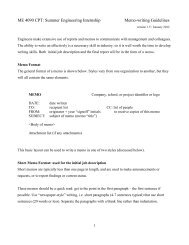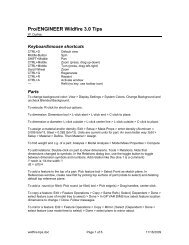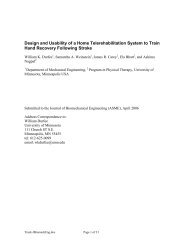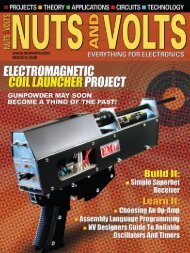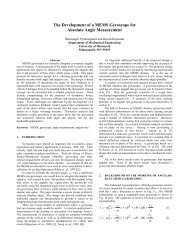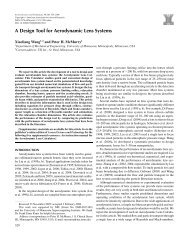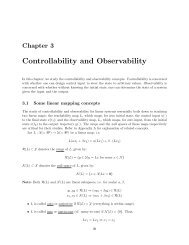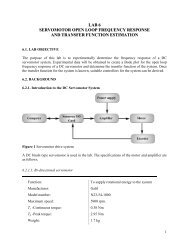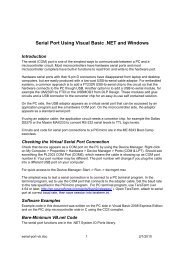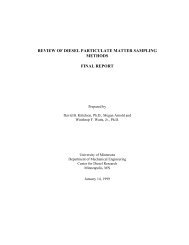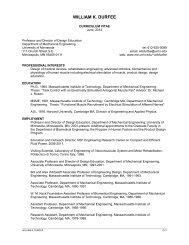Diesel Aerosol Measurement - Department of Mechanical ...
Diesel Aerosol Measurement - Department of Mechanical ...
Diesel Aerosol Measurement - Department of Mechanical ...
You also want an ePaper? Increase the reach of your titles
YUMPU automatically turns print PDFs into web optimized ePapers that Google loves.
variation <strong>of</strong> the electric field strength in the mobility analyzer causes a monotonic<br />
variation in the electrical mobility <strong>of</strong> the particles entering the particle collection slot.<br />
After allowances are made for particle residence times, the entire size distribution can be<br />
derived from a single scan. Scans <strong>of</strong> 100 particle-size intervals can be completed in 30 s.<br />
Scanning the voltage both up and down to generate two size distribution measurements<br />
can be completed in 60 s. Because the voltage is scanned rather than stepped, the number<br />
<strong>of</strong> size intervals is primarily limited by particle residence time and the speed at which the<br />
particles can be counted by the CNC (Keady, et. al. 1983), Pollack counter (Hoppel 1978)<br />
or electrometer (Liu and Pui 1974) (Winklmayr, et. al. 1991). The size interval is<br />
therefore defined by number counts over a voltage interval within the mobility analyzer<br />
voltage scan, thus the operating characteristics <strong>of</strong> the SMPS are dependent upon the<br />
particle counter being used.<br />
The SMPS can also be run in a single size mode as well as in a scanning mode. In the<br />
single size mode it measures a single particle size range continuously with a time<br />
resolution <strong>of</strong> a few seconds. In this mode it can be used for transient particle size<br />
measurements, one size range at a time (Greenwood, et. al. 1996). EMPA, Ford, and<br />
AEA are using this approach, although Ford has not applied the technique to diesel<br />
exhaust. The problem with this approach is that only one size range at a time is measured<br />
when a minimum <strong>of</strong> 3 to 5 size ranges are required to approximately describe the<br />
submicrometer size distribution. Therefore at least 3 to 5 transient tests are required to<br />
obtain one size distribution, which makes the approach time consuming and expensive.<br />
Alternatively, several instruments used in parallel, each measuring a different size, can be<br />
used, but this requires a large investment in instruments.<br />
Size distribution measurements with the SMPS will be biased if particle concentration or<br />
size changes during the time interval <strong>of</strong> the scan. This has typically precluded the use <strong>of</strong><br />
the SMPS over transient speed and engine load test cycles such as the U.S. EPA Heavy-<br />
Duty Transient Test without some means <strong>of</strong> providing a steady aerosol sample stream<br />
during the SMPS scan. A bag sampler that quickly fills and then allows an integrated,<br />
essentially constant, aerosol sample to be withdrawn during the SMPS scan could be<br />
used. Bag samples have been used to collect particles during transient test cycles and for<br />
on-highway studies (Chen, et al. 1984, Keady, et al., 1983 and Kapadia, 1980) and if<br />
losses are characterized and analysis times minimized, this approach may essentially<br />
eliminate this problem.<br />
[Authors’ Note: Based on conversations with the manufacturer <strong>of</strong> the SMPS (Havlicek,<br />
1998), versions 2.0 and 2.1 <strong>of</strong> the SMPS s<strong>of</strong>tware contained an error that caused number<br />
counts <strong>of</strong> nanoparticles less than 10 μm to be inaccurately high with CPC models 3022A<br />
and 3025A. The error has been corrected with the s<strong>of</strong>tware version 2.3 and the<br />
manufacturer has distributed this version to owners <strong>of</strong> affected systems. Data generated<br />
by the SMPS is stored as raw data, allowing previous aerosol measurements performed<br />
with the inaccurate s<strong>of</strong>tware version to be corrected with the updated s<strong>of</strong>tware. Although<br />
the error with SMPS may have caused inaccurately high number concentrations <strong>of</strong><br />
nanoparticles, results from studies <strong>of</strong> diesel exhaust with the correct SMPS s<strong>of</strong>tware<br />
8



